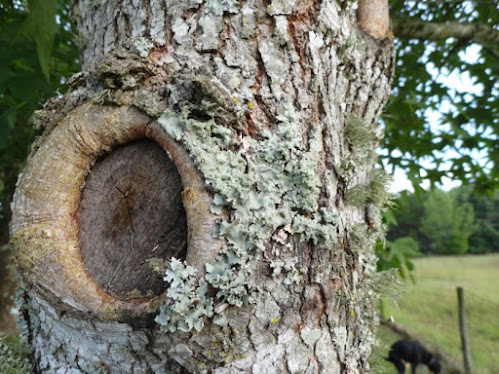Well, if it looks like the stuff clinging to the Sweetgum tree in the photo, it is neither one. It is lichen.
 Lichen is the result of a symbiotic relationship between fungi, algae and bacteria. And, other than clinging to this tree, or the cast iron bench or decorative stone in your backyard, it is doing nothing to the home it finds. It simply got lucky and found an opportune place to live. It may ugly up your favorite dogwood or eventually ruin the paint on that chair or arbor, but it will cause no disease or structural damage.
Lichen is the result of a symbiotic relationship between fungi, algae and bacteria. And, other than clinging to this tree, or the cast iron bench or decorative stone in your backyard, it is doing nothing to the home it finds. It simply got lucky and found an opportune place to live. It may ugly up your favorite dogwood or eventually ruin the paint on that chair or arbor, but it will cause no disease or structural damage.Leave that old car your grandparents left you which is parked by that old shed in the back and lichen will probably take a likin' to it as well, in a suitable environment.
Other than the fact that lichen is technically not moss or mold, (certain species may appear similar) lichen is not too happy in dark or heavily shaded areas. In this relationship the bacteria and algae photosynthesize and help feed the fungus. So, lichens usually are found in areas with adequate sunlight.
Although lichen can be found on ailing trees it is not the cause of such conditions. I do see lichen on many dying native dogwoods in the area and I experience it on trees no longer producing much foliage (dying native dogwoods) because the lichen has found a location now with adequate sunlight.
It can easily be found on healthy plants such as on the lower trunk area of mature trees which now have higher canopies, receiving more sunlight.
Yes, most lichen are not aesthetically pleasing. Believe it or not, some are. If you are wanting to remove lichen, try rubbing the bulk off with your hand or use the jet setting on your garden hose nozzle. If you try scraping it off with some tool be mindful of the bark below. You don't want to injure an already failing tree, or any tree, for that matter.
Some lichens have barely any elevation or texture and appear as discolorations of the host surface, and they are difficult to remove.
There are supposedly over 20,000 species of lichen that come in many colors, shapes and textures and there are four groups basically determined by form and texture. They all take on their appearance based on the varying species of fungi, algae and bacteria involved.
So, if you see this stuff on your property, don't liken it to some ill-willed disease causing problem. Who knows? You may take a lichen to it.
Okay, I'll stop. Like, right now.



No comments:
Post a Comment